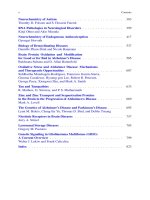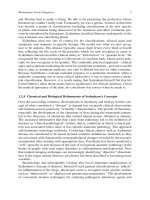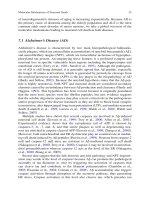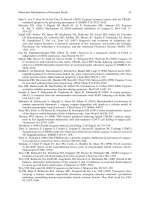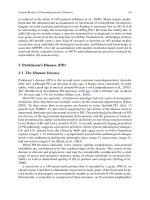Neurochemical Mechanisms in Disease P64 docx
Bạn đang xem bản rút gọn của tài liệu. Xem và tải ngay bản đầy đủ của tài liệu tại đây (132.1 KB, 10 trang )
Oxidative Stress and AD: Mechanisms and Therapeutics 615
These findings establish a link between oxidative stress and mitochondria, cre-
ating a pathological feedback loop, although in other cell types such as astrocytes,
which are known to regulate glutathione availability, mitochondria are unaffected
(Pope et al., 2008).
Mitochondria are also susceptible to apoptotic pathways, mediated through mem-
bers of (a) Bcl-2 family (Bid, Bad, and Bax), (b) death receptor pathway, and
(c) endoplasmic-reticulum-specific pathway. The final result of these three pathways
is the activation of caspases (Ferri and Kroemer, 2001). It has been reported that the
neurons exhibiting increased oxidative damage in AD are coincident with striking
and significant increase in cytochrome oxidases and mtDNA (Hirai et al., 2001).
Cytochrome oxidase is found in the neuronal cytoplasm and mtDNA in vacuoles
associated with lipofuscin. Furthermore, lipoic acid antisera specifically mark lipo-
fuscin in AD, suggesting increased autophagocytosis (Moreira et al., 2007). Also, a
significant reduction of intact mitochondria, as well as a reduction in microtubules,
is found in AD (Cash et al., 2003). Oxidative stress markers, mtDNA deletion,
and abnormalities in mitochondrial structure in the vascular walls of AD cases
are also increased (Aliev et al., 2004). In addition to changes in mitochondrial
enzymes, mitochondrial structure, localization, and mobility are all changed in AD.
Specifically, markers for mitochondrial fission and fusion are altered in models of
AD and are affected by Aβ oligomers, which impair mitochondrial function, leading
to energy hypometabolism and elevated reactive oxygen species production (Wang
et al., 2007b, 2008a,b).
In sum, it is apparent that mitochondria and oxidative stress are closely related
and together, through different pathways, contribute to the neurodegenerative
process.
3.3 Metals
The other important source of free radicals comes from redox-active metals.
Strikingly, NFT and Aβ plaques were found coincident with overaccumulation of
iron in the hippocampus, cerebral cortex, and basal nucleus of Meynert (Lovell et al.,
1998). Iron is an important cause of oxidative stress in AD through the Fenton reac-
tion. Aβ is also a substrate for hydroxyl radicals and, in the presence of iron, it has
been reported that cleavage and synthesis of Aβ are promoted (Atwood et al., 1999;
Rogers et al., 2002).
Copper can also participate in the Fenton reaction to generate ROS (Huang et al.,
1999b; Finefrock et al., 2003) and is affected by Aβ (Hayashi et al., 2007; Nakamura
et al., 2007). Furthermore, iron and copper in their redox competent states are bound
to NFT and Aβ deposits (Smith et al., 1997a; Sayre et al., 2000). Nevertheless, the
exact role of copper and iron in their redox competent states remains to be eluci-
dated. In this regard, it is been suggested that mitochondrial dysfunction, acting in
concert with cytoskeletal pathology, serves to increase redox-active heavy metals
and initiates a cascade of abnormal events culminating in AD pathology (Castellani
et al., 2004).
616 S. Mondragón-Rodríguez et al.
4 Current and Future Pharmacological Treatments
for Alzheimer Disease
An enormous effort has been devoted to developing treatments for the clinical
symptoms of AD. Cholinesterase inhibitors, antiglutamatergic treatment, β- and
γ-secretase inhibitors, cholesterol-lowering drugs, Aβ immunotherapy, nonsteroidal
anti-inflammatory drugs, Aβ channel blockers, hormonal replacement therapy, and
antioxidant therapies are the current pharmacological options for treatment of AD
(Bartus et al., 1982; Schenk et al., 1999; Pratico and Trojanowski, 2000; Dovey
et al., 2001; Golde and Eckman, 2001; Nunomura et al., 2001; Cholerton et al.,
2002; Farlow et al., 2003; Perry et al., 2003; Moreira et al., 2006; Diaz et al., 2009;
Lopez-Bastida et al., 2009; Moriguchi et al., 2009).
Cholinergic transmission plays a fundamental role in cognitive function. Due
to a reported decrease of cholinergic function in the neocortex and hippocam-
pus, several acetylcholinesterase inhibitors have been used to treat AD in the past
few years, such as tacrine, donepezil, rivastigmine, and galactine (Lleo et al.,
2005; Moriguchi et al., 2009). Acetylcholinesterase inhibitors can delay cogni-
tive impairment for at least six months (Takeda et al., 2006). Indeed, these drugs
have been found to possess some antioxidant properties as well as neuroprotec-
tive properties (Fernandez-Bachiller et al., 2009). However, they were recently
shown to have opposing effects on blood pressure and cerebral perfusion (Claassen
et al., 2009).
The most important excitatory neurotransmitter in the central nervous system
(CNS) is glutamate, reported to regulate Ca
2+
accumulation through excessive acti-
vation of NMDA receptors. Memantine is an NMDA antagonist that has been used
to treat neurological syndromes and cognitive dysfunction (Farlow et al., 2003). A
small beneficial effect of memantine was observed at six months of treatment in
moderate to severe AD (Areosa et al., 2005).
Numerous studies have supported the idea that an oxidative event is critical in
AD. It is thought that Aβ is capable of generating reactive oxygen species. However,
the source of Aβ toxicity has yet to be established (Rottkamp et al., 2001). Although
deposition of Aβ into senile plaques is by no means specific to AD, several treat-
ments against Aβ deposition are currently in use. In this context β- and γ-secretase
inhibitors have been used therapeutically. Although the main goal is to block the
production of Aβ (Josien, 2002), γ-secretase inhibitors also block the proteolytic
processing and function of Notch, which i s essential for brain morphogenesis (Louvi
et al., 2004). In contrast, no side effects have been found with β-secretase inhibitors
in knock-out mice (Dominguez et al., 2005). Indeed, novel therapeutic strategies
contemplate the use of dual effectors, such as the new dual inhibitor of acetyl-
cholinesterase and β-secretase (Zhu et al., 2009). The preliminary data in transgenic
mice looks promising.
Cholesterol has been reported to negatively regulate α-secretase, whereas β- and
γ-secretase activities are positively regulated by cholesterol (Golde and Eckman,
2001). Disappointingly, a three-year trial with pravastatin (a cholesterol-lowering
Oxidative Stress and AD: Mechanisms and Therapeutics 617
drug) showed no significant effect on cognitive function in elderly individuals
(Shepherd et al., 2002).
Aβ immunization is a novel approach to AD treatment. Simple immunization
with Aβ42 in transgenic mice blocked deposition of amyloid and cleared existing
amyloid (Schenk et al., 1999; Boche et al., 2008). Recently, increased dendritic
spine formation in PDAPP transgenic mice was found after amyloid clearance, sug-
gesting functional recovery of neural circuits (Spires-Jones et al., 2009). However,
active vaccination with Aβ in patients with mild to moderate AD in a Phase II trial
showed a CNS inflammatory response (Monsonego et al., 2003). The meningoen-
cephalitis that occurred in some of the patients was reported to be unrelated to the
anti-Aβ antibody titer (Hock et al., 2003; Wilcock and Colton, 2008), but rather
to the involvement of a specific T-cell inflammatory response (Ferrer et al., 2004).
Others have speculated that the adverse effects were due to external contamination
during lumbar punctures, which were required as part of the protocol (Dodel et al.,
2003). Furthermore, Fox and colleagues (Fox et al., 2005) showed, by standard vol-
umetry, that the brains of vaccinated individuals lost tissue and gained ventricular
volume faster than did brains of individuals vaccinated with placebo. If, as we sus-
pect, Aβ is functioning as an antioxidant, removal of Aβ by immunization and/or
other methods may actually exacerbate disease progression.
Extensive epidemiological data suggest a gender-based predisposition that is spe-
cific to AD such that there is a higher prevalence (Jorm et al., 1987; Breitner et al.,
1988; Rocca et al., 1991; McGonigal et al., 1993) and incidence (Jorm and Jolley,
1998) of AD in women. Hormone replacement therapy protection against AD is
restricted to administration during a “critical period” that constitutes the climacteric
years. Efficacy is variable when administered after such time (Rapp et al., 2003)
or during the latent preclinical stage of AD, which usually occurs much later in
life (Resnick and Henderson, 2002; Craig and Murphy, 2009; Henderson, 2009;
Hogervorst et al., 2009). The mechanism(s) relating hormones and pathology is
(are) being actively pursued; it has been proposed that luteinizing hormone may
contribute to AD pathology through an amyloid-dependent mechanism (Casadesus
et al., 2006; Webber et al., 2007; Berry et al., 2008), that again underlies the bias
towards females developing AD. In this regard, previous reports demonstrate a
twofold increase in the gonadotropin LH in AD patients compared to age-matched
control subjects (Bowen et al., 2000; Short et al., 2001; Webber et al., 2007). Thus,
the presence of functional LH receptors was, at least i n part, responsible for the cog-
nitive decline seen in transgenic mice (Casadesus et al., 2007). Additionally, it has
been reported that increased serum LH, rather than lower serum-free testosterone, is
associated with the accumulation of Aβ in plasma (Verdile et al.,
2008). Therefore,
therapeutic strategies that are targeted towards decreasing LH may prove successful
in treatment of AD (Webber et al., 2006, 2007; Casadesus et al., 2008).
Because chronic inflammation is associated with AD, several anti-inflamatory
drugs have been tested including celecoxib (sc-125; sc-560), r-flurbiprofen,
naproxen, and rocoxib (Szekely et al., 2004). Unfortunately, no consistent improve-
ment in AD symptoms after treatment has been reported.
618 S. Mondragón-Rodríguez et al.
The involvement of oxidative stress in AD has opened a new door for potential
therapeutic targets. In this regard, several antioxidants are currently in clinical tri-
als such as Idebenone, α-Lipoic acid, acetyl-L-carnitine (ALC), vitamin E, vitamin
C, flavonoids, β-carotene, gingko biloba, and metal-chelating agents. Idebenone is
a metabolic antioxidant and is normally synthesized as part of the mitochondrial
oxidative phosphorylation system. Improvements in clinical status after treatment
with idebenone have been shown in a dose-dependent manner compared to placebo
and tacrine (Thal et al., 2003).
α-Lipoic acid is another metabolic antioxidant that can recycle other antioxi-
dants such as glutathione. Patients treated with α-Lipoic acid exhibited stabilization
of cognitive measures (Hager et al., 2001). Acetyl-L-carnitine (ALC) is another
metabolic antioxidant that acts as an intracellular carrier of acetyl groups across the
inner mitochondrial membrane. Treatment with ALC showed a 38% response rate,
and 50% when combined with acetyl cholinesterase inhibitors (Montgomery et al.,
2003).
Vitamins, flavonoids, and terpenoids are examples of direct antioxidants
(McShea et al., 2008; Ramiro-Puig et al., 2009). Vitamin E and selegiline appear to
delay the time of progression to severe dementia in AD patients (Sano et al., 1997;
Grundman, 2000). Vitamin E is the most important lipid-soluble chain-breaking
natural antioxidant in mammalian cells and is able to cross the blood–brain barrier
and accumulate at therapeutic levels in the brain, where it reduces lipid peroxidation
(Veinbergs et al., 2000). In a cross-sectional study of 4809 elderly, decreasing serum
levels of vitamin E per unit of cholesterol were consistently associated with decreas-
ing cognitive function, whereas serum levels of vitamins A and C, β-carotene, and
selenium were not associated with poor memory performance (Perkins et al., 1999).
The Chicago Health and Aging Project with samples of 2889 community residents
aged 65–102 years found that supplementary or dietary intake of vitamin E, but
not vitamin C or carotenes, was inversely related to cognitive decline (Morris et al.,
2002b). However, data from prospective studies relating intake of vitamin E and risk
of AD are conflicting. The Chicago Health and Aging Project found that dietary, but
not supplementary, intake of vitamin E was associated with a lowered risk of AD
only among noncarriers of the ApoE ε4 allele (Morris et al., 2002a). Furthermore,
in the Washington Heights–Inwood Columbia Aging Project, no association was
found between dietary or supplementary intake of vitamin E and a decreased risk
of AD (Luchsinger et al., 2003). The lack of efficacy of vitamin E in preventing the
progression from MCI to AD indicates that single supplementary vitamin treatment
has no significant affect in the secondary prevention of AD, which is consistent
with the previous cohort studies on the progression to AD from the cognitively nor-
mal elderly. Gingko biloba contains, among other things, flavonoids and terpenoids.
No differences in soluble Aβ and hippocampal Aβ were found in mice treated with
Gingko biloba, although they showed improved spatial memory retention (Stackman
et al., 2003).
Thus, re-examination of metal-chelating agents, classical indirect antioxidants,
is warranted. NFT and senile plaques have been shown to contain redox-active tran-
sition metals (Smith et al., 1997a; Sayre et al., 2000) and may exert pro-oxidant
Oxidative Stress and AD: Mechanisms and Therapeutics 619
or maybe antioxidant activities, depending on the local microenviroment. Aβ trans-
genic mice exhibited a 40% decrease in Aβ deposition after a nine-week treatment
with clioquinol, a metal–protein chelating agent (Cherny et al., 2001). In two
familial AD patients, increases in cerebral glucose metabolism were present after
extended clioquinol treatment (Ibach et al., 2005).
5 Conclusion
As discussed in this chapter, oxidative stress plays an important role in AD, but
more importantly, oxidative stress seems to be an early event, preceding classic
fibril formation (Aβ plaques and NFT). Fibril formation can be explained as a com-
pensatory mechanism that eventually enhances oxidative stress by increasing ROS
levels among many other free radicals. In this scenario, deposition of Aβ in the
extracellular environment and tau protein in the intracellular environment can be
explained as an imbalance and tragic consequence. If this hypothesis is current, the
current pharmacological treatments will not provide a solution, because the majority
are directed against the fibril structures. In contrast, antioxidant strategies may be
helpful in treating AD symptoms, although significant extended benefits have not
been realized to date.
In sum, the damage observed in the brain tissue of AD patients that is enhanced
by the fibril structures may be minimized with a healthy daily diet, exercise, and
intellectual activities as the best option so far.
References
Aliev G, Smith MA, de la Torre JC, Perry G (2004) Mitochondria as a primary target for vascular
hypoperfusion and oxidative stress in Alzheimer’s disease. Mitochondrion 4:649–663
Allen DD, Galdzicki Z, Brining SK, Fukuyama R, Rapoport SI, Smith QR (1997) Beta-amyloid
induced increase in choline flux across PC12 cell membranes. Neurosci Lett 234:71–73
Alonso AC, Grundke-Iqbal I, Iqbal K (1996) Alzheimer’s disease hyperphosphorylated tau
sequesters normal tau into tangles of filaments and disassembles microtubules. Nat Med
2:783–787
Alonso A, Zaidi T, Novak M, Grundke-Iqbal I, Iqbal K (2001) Hyperphosphorylation induces self-
assembly of tau into tangles of paired helical filaments/straight filaments. Proc Natl Acad Sci
U S A 98:6923–6928
Areosa SA, Sherriff F, McShane R (2005) Memantine for dementia. Cochrane Database Syst Rev
19(2):CD003154
Arriagada PV, Growdon JH, Hedley-Whyte ET, Hyman BT (1992) Neurofibrillary tangles but not
senile plaques parallel duration and severity of Alzheimer’s disease. Neurology 42:631–639
Asuni AA, Boutajangout A, Scholtzova H, Knudsen E, Li YS, Quartermain D, Frangione B,
Wisniewski T, Sigurdsson EM (2006) Vaccination of Alzheimer’s model mice with Abeta
derivative in alum adjuvant reduces Abeta burden without microhemorrhages. Eur J Neurosci
24:2530–2542
Atamna H (2004) Heme, iron, and the mitochondrial decay of ageing. Ageing Res Rev 3:303–318
Atwood CS, Huang X, Moir RD, Tanzi RE, Bush AI (1999) Role of free radicals and metal ions in
the pathogenesis of Alzheimer’s disease. Met Ions Biol Syst 36:309–364
620 S. Mondragón-Rodríguez et al.
Atwood CS, Obrenovich ME, Liu T, Chan H, Perry G, Smith MA, Martins RN (2003) Amyloid-
beta: a chameleon walking in two worlds: a review of the trophic and toxic properties of
amyloid-beta. Brain Res Brain Res Rev 43:1–16
Ball MJ, Griffin-Brooks S, MacGregor JA, Nagy B, Ojalvo-Rose E, Fewster PH (1988)
Neuropathological definition of Alzheimer disease: multivariate analyses in the morphomet-
ric distinction between Alzheimer dementia and normal aging. Alzheimer Dis Assoc Disord
2:29–37
Bartus RT, Dean RL 3rd, Beer B, Lippa AS (1982) The cholinergic hypothesis of geriatric memory
dysfunction. Science 217:408–414
Basurto-Islas G, Luna-Munoz J, Guillozet-Bongaarts AL, Binder LI, Mena R, Garcia-Sierra F
(2008) Accumulation of aspartic acid421- and glutamic acid391-cleaved tau in neurofibril-
lary tangles correlates with progression in Alzheimer disease. J Neuropathol Exp Neurol 67:
470–483
Berry A, Tomidokoro Y, Ghiso J, Thornton J (2008) Human chorionic gonadotropin (a luteiniz-
ing hormone homologue) decreases spatial memory and increases brain amyloid-beta levels in
female rats. Horm Behav 54:143–152
Blass JP, Gibson GE (1999) Cerebrometabolic aspects of delirium in relationship to dementia.
Dement Geriatr Cogn Disord 10:335–338
Blass JP, Sheu RK, Gibson GE (2000) Inherent abnormalities in energy metabolism in Alzheimer
disease. Interaction with cerebrovascular compromise. Ann N Y Acad Sci 903:204–221
Boche D, Zotova E, Weller RO, Love S, Neal JW, Pickering RM, Wilkinson D, Holmes C , Nicoll
JA (2008) Consequence of Abeta immunization on the vasculature of human Alzheimer’s
disease brain. Brain 131:3299–3310
Bowen RL, Isley JP, Atkinson RL (2000) An association of elevated serum gonadotropin
concentrations and Alzheimer disease? J Neuroendocrinol 12:351–354
Breitner JC, Silverman JM, Mohs RC, Davis KL (1988) Familial aggregation in Alzheimer’s dis-
ease: comparison of risk among relatives of early-and late-onset cases, and among male and
female relatives in successive generations. Neurology 38:207–212
Bubber P, Haroutunian V, Fisch G, Blass JP, Gibson GE (2005) Mitochondrial abnormalities in
Alzheimer brain: mechanistic implications. Ann Neurol 57:695–703
Buee L, Bussiere T, B uee-Scherrer V, Delacourte A, Hof PR (2000) Tau protein isoforms,
phosphorylation and role in neurodegenerative disorders. Brain Res Brain Res Rev 33:95–130
Butterfield DA, Castegna A, Lauderback CM, Drake J (2002) Evidence that amyloid beta-peptide-
induced lipid peroxidation and its sequelae in Alzheimer’s disease brain contribute to neuronal
death. Neurobiol Aging 23:655–664
Casadesus G, Garrett MR, Webber KM, Hartzler AW, Atwood CS, Perry G, Bowen RL, Smith
MA (2006) The estrogen myth: potential use of gonadotropin-releasing hormone agonists for
the treatment of Alzheimer’s disease. Drugs R D 7:187–193
Casadesus G, Milliken EL, Webber KM, Bowen RL, Lei Z, Rao CV, Perry G, Keri RA, Smith MA
(2007) Increases in luteinizing hormone are associated with declines in cognitive performance.
Mol Cell Endocrinol 269:107–111
Casadesus G, Rolston RK, Webber KM, Atwood CS, Bowen RL, Perry G, Smith MA (2008)
Menopause, estrogen, and gonadotropins in Alzheimer’s disease. Adv Clin Chem 45:
139–153
Casadesus G, Smith MA, Zhu X, Aliev G, Cash AD, Honda K, Petersen RB, Perry G (2004)
Alzheimer disease: evidence for a central pathogenic role of iron-mediated reactive oxygen
species. J Alzheimers Dis 6:165–169
Cash AD, Aliev G, Siedlak SL, Nunomura A, Fujioka H, Zhu X, Raina AK, Vinters HV, Tabaton
M, Johnson AB, Paula-Barbosa M, Avila J, Jones PK, Castellani RJ, Smith MA, Perry G
(2003) Microtubule reduction in Alzheimer’s disease and aging is independent of tau filament
formation. Am J Pathol 162:1623–1627
Cash AD, Perry G, Ogawa O, Raina AK, Zhu X, Smith MA (2002) Is Alzheimer’s disease a
mitochondrial disorder? Neuroscientist 8:489–496
Oxidative Stress and AD: Mechanisms and Therapeutics 621
Castellani RJ, Harris PL, Sayre LM, Fujii J, Taniguchi N, Vitek MP, Founds H, Atwood CS,
Perry G, Smith MA (2001) Active glycation in neurofibrillary pathology of Alzheimer disease:
N(epsilon)-(carboxymethyl) lysine and hexitol-lysine. Free Radic Biol Med 31:175–180
Castellani RJ, Honda K, Zhu X, Cash AD, Nunomura A, Perry G, Smith MA (2004) Contribution
of redox-active iron and copper to oxidative damage in Alzheimer disease. Ageing Res Rev
3:319–326
Castellani RJ, Lee HG, Perry G, Smith MA (2006) Antioxidant protection and neurodegenerative
disease: the role of amyloid-beta and tau. Am J Alzheimers Dis Other Demen 21:126–130
Castellani RJ, Lee HG, Zhu X, Perry G, Smith MA (2008) Alzheimer disease pathology as a host
response. J Neuropathol Exp Neurol 67:523–531
Caughey B, Lansbury PT (2003) Protofibrils, pores, fibrils, and neurodegeneration: separating the
responsible protein aggregates from the innocent bystanders. Annu Rev Neurosci 26:267–298
Chen S, Li B, Grundke-Iqbal I, Iqbal K (2008) I1PP2A affects tau phosphorylation via association
with the catalytic subunit of protein phosphatase 2A. J Biol Chem 283(16):10513–10521
Cherny RA, Atwood CS, Xilinas ME, Gray DN, Jones WD, McLean CA, Barnham KJ, Volitakis I,
Fraser FW, Kim Y, Huang X, Goldstein LE, Moir RD, Lim JT, Beyreuther K, Zheng H,
Tanzi RE, Masters CL, Bush AI (2001) Treatment with a copper-zinc chelator markedly and
rapidly inhibits beta-amyloid accumulation in Alzheimer’s disease transgenic mice. Neuron 30:
665–676
Cholerton B, Gleason CE, Baker LD, Asthana S (2002) Estrogen and Alzheimer’s disease: the
story so far. Drugs Aging 19:405–427
Claassen JA, Van Beek AH, Olde Rikkert MG (2009) Short review: acetylcholinesterase-inhibitors
in Alzheimer’s disease have opposing effects on blood pressure and cerebral perfusion. J Nutr
Health Aging 13:231–233
Craig MC, Murphy DG (2009) Alzheimer’s disease in women. Best Pract Res Clin Obstet
Gynaecol 23:53–61
Cuajungco MP, Frederickson CJ, Bush AI (2005) Amyloid-beta metal interaction and metal
chelation. Subcell Biochem 38:235–254
Cuchillo-Ibanez I, Seereeram A, Byers HL, Leung KY, Ward MA, Anderton BH, Hanger DP
(2008) Phosphorylation of tau regulates its axonal transport by controlling its binding to
kinesin. FASEB J 22(9):3186–3195
Dahlgren KN, Manelli AM, Stine WB Jr., Baker LK, Krafft GA, LaDu MJ (2002) Oligomeric and
fibrillar species of amyloid-beta peptides differentially affect neuronal viability. J Biol Chem
277:32046–32053
Davis DG, Schmitt FA, Wekstein DR, Markesbery WR (1999) Alzheimer neuropathologic
alterations in aged cognitively normal subjects. J Neuropathol Exp Neurol 58:376–388
de Carvalho CV, Payao SL, Smith MA (2000) DNA methylation, ageing and ribosomal genes
activity. Biogerontology 1:357–361
Diaz JC, Simakova O, Jacobson KA, Arispe N, Pollard HB (2009) Small molecule blockers of the
Alzheimer Abeta calcium channel potently protect neurons from Abeta cytotoxicity. Proc Natl
Acad Sci U S A 106:3348–3353
Dickson DW, Crystal HA, Mattiace LA, Masur DM, Blau AD, Davies P, Yen SH, Aronson MK
(1992) Identification of normal and pathological aging in prospectively studied nondemented
elderly humans. Neurobiol Aging 13:179–189
Dodel RC, Hampel H, Du Y (2003) Immunotherapy for Alzheimer’s disease. Lancet Neurol 2:
215–220
Dominguez D, Tournoy J, Hartmann D, Huth T, Cryns K, Deforce S, Serneels L, Camacho IE,
Marjaux E, Craessaerts K, Roebroek AJ, Schwake M, D’Hooge R, Bach P, Kalinke U,
Moechars D, Alzheimer C, Reiss K, Saftig P, De Strooper B (2005) Phenotypic and biochemical
analyses of BACE1- and BACE2-deficient mice. J Biol Chem 280:30797–30806
Dong J, Atwood CS, Anderson VE, Siedlak SL, Smith MA, Perry G, Carey PR (2003) Metal
binding and oxidation of amyloid-beta within isolated senile plaque cores: Raman microscopic
evidence. Biochemistry (Mosc) 42:2768–2773
622 S. Mondragón-Rodríguez et al.
Dovey HF, John V, Anderson JP, Chen LZ, de Saint Andrieu P, Fang LY, Freedman SB, Folmer
B, Goldbach E, Holsztynska EJ, Hu KL, Johnson-Wood KL, Kennedy SL, Kholodenko D,
Knops JE, Latimer LH, Lee M, Liao Z, Lieberburg IM, Motter RN, Mutter LC, Nietz J,
Quinn KP, Sacchi KL, Seubert PA, Shopp GM, Thorsett ED, Tung JS, Wu J, Yang S, Yin
CT, Schenk DB, May PC, Altstiel LD, Bender MH, Boggs LN, Britton TC, Clemens JC, Czilli
DL, Dieckman-McGinty DK, Droste JJ, Fuson KS, Gitter BD, Hyslop PA, Johnstone EM, Li
WY, Little SP, Mabry TE, Miller FD, Audia JE (2001) Functional gamma-secretase inhibitors
reduce beta-amyloid peptide levels in brain. J Neurochem 76:173–181
Drzezga A, Lautenschlager N, Siebner H, Riemenschneider M, Willoch F, Minoshima S,
Schwaiger M, Kurz A (2003) Cerebral metabolic changes accompanying conversion of mild
cognitive impairment into Alzheimer’s disease: a PET follow-up study. Eur J Nucl Med Mol
Imaging 30:1104–1113
Dwyer BE, Zacharski LR, Balestra DJ, Lerner AJ, Perry G, Zhu X, Smith MA (2009) Getting the
iron out: Phlebotomy for Alzheimer’s disease? Med Hypotheses 72:504–509
Erecinska M, Silver IA (1989) ATP and brain function. J Cereb Blood Flow Metab 9:2–19
Evans TA, Raina AK, Delacourte A, Aprelikova O, Lee HG, Zhu X, Perry G, Smith MA (2007)
BRCA1 may modulate neuronal cell cycle re-entry in Alzheimer disease. Int J Med Sci 4:
140–145
Farlow MR, Tariot P, Grossberg GT, Gergel I, Grahm S, Jin J (2003) Memantine/donepezil
dual therapy is superior to placebo/donepezil therapy for treatment of moderate to severe
Alzheimer’s disease. Neurology 60:A412
Fernandez-Bachiller MI, Perez C, Campillo NE, Paez JA, Gonzalez-Munoz GC, Usan P, Garcia-
Palomero E, Lopez MG, Villarroya M, Garcia AG, Martinez A, Rodriguez-Franco MI
(2009) Tacrine-Melatonin Hybrids as Multifunctional Agents for Alzheimer’s Disease, with
Cholinergic, Antioxidant, and Neuroprotective Properties. ChemMedChem 4(5):828–841
Ferrer I, Boada Rovira M, Sanchez Guerra ML, Rey MJ, Costa-Jussa F (2004) Neuropathology
and pathogenesis of encephalitis following amyloid-beta immunization in Alzheimer’s disease.
Brain Pathol 14:11–20
Ferri KF, Kroemer G (2001) Organelle-specific initiation of cell death pathways. Nat Cell Biol
3:E255–E263
Finefrock AE, Bush AI, Doraiswamy PM (2003) Current status of metals as therapeutic targets in
Alzheimer’s disease. J Am Geriatr Soc 51:1143–1148
Floyd RA, Hensley K (2002) Oxidative stress in brain aging. Implications for therapeutics of
neurodegenerative diseases. Neurobiol Aging 23:795–807
Fox NC, Black RS, Gilman S, Rossor MN, Griffith SG, Jenkins L, Koller M (2005) Effects of
Abeta immunization (AN1792) on MRI measures of cerebral volume in Alzheimer disease.
Neurology 64:1563–1572
Gamblin TC, Chen F, Zambrano A, Abraha A, Lagalwar S, Guillozet AL, Lu M, Fu Y, Garcia-
Sierra F, LaPointe N, Miller R, Berry RW, Binder LI, Cryns VL (2003) Caspase cleavage of
tau: linking amyloid and neurofibrillary tangles in Alzheimer’s disease. Proc Natl Acad Sci
U S A 100:10032–10037
Garcia ML, Cleveland DW (2001) Going new places using an old MAP: tau, microtubules and
human neurodegenerative disease. Curr Opin Cell Biol 13:41–48
Garcia-Sierra F, Wischik CM, Harrington CR, Luna-Munoz J, Mena R (2001) Accumulation of
C-terminally truncated tau protein associated with vulnerability of the perforant pathway in
early stages of neurofibrillary pathology in Alzheimer’s disease. J Chem Neuroanat 22:65–77
Giannakopoulos P, Herrmann FR, Bussiere T, B ouras C, Kovari E, Perl DP, Morrison JH, Gold G,
Hof PR (2003) Tangle and neuron numbers, but not amyloid load, predict cognitive status in
Alzheimer’s disease. Neurology 60:1495–1500
Gibson GE, Park LC, Sheu KF, Blass JP, Calingasan NY (2000) The alpha-ketoglutarate
dehydrogenase complex in neurodegeneration. Neurochem Int 36:97–112
Goedert M, Cuenda A, Craxton M, Jakes R, Cohen P (1997) Activation of the novel stress-
activated protein kinase SAPK4 by cytokines and cellular stresses is mediated by SKK3
Oxidative Stress and AD: Mechanisms and Therapeutics 623
(MKK6); comparison of its substrate specificity with that of other SAP kinases. EMBO J 16:
3563–3571
Goedert M, Spillantini MG, Davies SW (1998) Filamentous nerve cell inclusions in neurodegen-
erative diseases. Curr Opin Neurobiol 8:619–632
Gold G, Kovari E, Corte G, Herrmann FR, Canuto A, Bussiere T, Hof PR, Bouras C,
Giannakopoulos P (2001) Clinical validity of A beta-protein deposition staging in brain aging
and Alzheimer disease. J Neuropathol Exp Neurol 60:946–952
Golde TE, Eckman CB (2001) Cholesterol modulation as an emerging strategy for the treatment
of Alzheimer’s disease. Drug Discov Today 6:1049–1055
Gomez-Isla T, Hollister R, West H, Mui S, Growdon JH, Petersen RC, Parisi JE, Hyman BT (1997)
Neuronal loss correlates with but exceeds neurofibrillary tangles in Alzheimer’s disease. Ann
Neurol 41:17–24
Grundman M (2000) Vitamin E and Alzheimer disease: the basis for additional clinical trials. Am
J Clin Nutr 71:630S–636S
Guillozet-Bongaarts AL, Cahill ME, Cryns VL, Reynolds MR, Berry RW, Binder LI (2006)
Pseudophosphorylation of tau at serine 422 inhibits caspase cleavage: in vitro evidence and
implications for tangle formation in vivo. J Neurochem 97:1005–1014
Guix FX, Ill-Raga G, Bravo R, Nakaya T, de Fabritiis G, Coma M, Miscione GP, Villa-Freixa J,
Suzuki T, Fernandez-Busquets X, Valverde MA, de Strooper B, Munoz FJ (2009) Amyloid-
dependent triosephosphate isomerase nitrotyrosination induces glycation and tau fibrillation.
Brain 132(Pt 5):1335–1345
Hager K, Marahrens A, Kenklies M, Riederer P, Munch G (2001) Alpha-lipoic acid as a new
treatment option for Azheimer type dementia. Arch Gerontol Geriatr 32:275–282
Halliwell B (1999) Antioxidant defence mechanisms: from the beginning to the end (of the
beginning). Free Radic Res 31:261–272
Hamaguchi T, Yamada M (2008) [Genetic factors for cerebral amyloid angiopathy]. Brain Nerve
60:1275–1283
Hamdane M, Delobel P, Sambo AV, Smet C, Begard S, Violleau A, Landrieu I, Delacourte A,
Lippens G, Flament S, Buee L (2003) Neurofibrillary degeneration of the Alzheimer-type: an
alternate pathway to neuronal apoptosis? Biochem Pharmacol 66:1619–1625
Hayashi T, Shishido N, Nakayama K, Nunomura A, Smith MA, Perry G, Nakamura M (2007)
Lipid peroxidation and 4-hydroxy-2-nonenal formation by copper ion bound to amyloid-beta
peptide. Free Radic Biol Med 43:1552–1559
Henderson VW (2009) Menopause, cognitive ageing and dementia: practice implications.
Menopause Int 15:41–44
Hirai K, Aliev G, Nunomura A, Fujioka H, Russell RL, Atwood CS, Johnson AB, Kress Y, Vinters
HV, Tabaton M, Shimohama S, Cash AD, Siedlak SL, Harris PL, Jones PK, Petersen RB,
Perry G, Smith MA (2001) Mitochondrial abnormalities in Alzheimer’s disease. J Neurosci
21:3017–3023
Hock C, Konietzko U, Streffer JR, Tracy J, Signorell A, Muller-Tillmanns B, Lemke U, Henke
K, Moritz E, Garcia E, Wollmer MA, Umbricht D, de Quervain DJ, Hofmann M, Maddalena
A, Papassotiropoulos A, Nitsch RM (2003) Antibodies against beta-amyloid slow cognitive
decline in Alzheimer’s disease. Neuron 38:547–554
Hogervorst E, Yaffe K, Richards M, Huppert FA (2009) Hormone replacement therapy to maintain
cognitive function in women with dementia. Cochrane Database Syst Rev (1):CD003799
Holley AK, St Clair DK (2009) Watching the watcher: regulation of p53 by mitochondria. Future
Oncol 5:117–130
House E, Collingwood J, Khan A, Korchazkina O, Berthon G, Exley C (2004) Aluminium, iron,
zinc and copper influence the in vitro formation of amyloid fibrils of Abeta42 in a manner which
may have consequences for metal chelation therapy in Alzheimer’s disease. J Alzheimers Dis
6:291–301
Hoyer S (1992) Oxidative energy metabolism in Alzheimer brain. Studies in early-onset and late-
onset cases. Mol Chem Neuropathol 16:207–224
624 S. Mondragón-Rodríguez et al.
Hoyer S (1998) Risk factors for Alzheimer’s disease during aging. Impacts of glucose/energy
metabolism. J Neural Transm Suppl 54:187–194
Huang X, Atwood CS, Hartshorn MA, Multhaup G, Goldstein LE, Scarpa RC, Cuajungco MP,
Gray DN, Lim J, Moir RD, Tanzi RE, Bush AI (1999a) The A beta peptide of Alzheimer’s
disease directly produces hydrogen peroxide through metal ion reduction. Biochemistry (Mosc)
38:7609–7616
Huang X, Cuajungco MP, Atwood CS, Hartshorn MA, Tyndall JD, Hanson GR, Stokes KC,
Leopold M, Multhaup G, Goldstein LE, Scarpa RC, Saunders AJ, Lim J, Moir RD, Glabe
C, Bowden EF, Masters CL, Fairlie DP, Tanzi RE, Bush AI (1999b) Cu(II) potentiation of
alzheimer abeta neurotoxicity. Correlation with cell-free hydrogen peroxide production and
metal reduction. J Biol Chem 274:37111–37116
Ibach B, Haen E, Marienhagen J, Hajak G (2005) Clioquinol treatment in familiar early onset of
Alzheimer’s disease: a case report. Pharmacopsychiatry 38:178–179
Johnson GV, Hartigan JA (1999) Tau protein in normal and Alzheimer’s disease brain: an update.
J Alzheimers Dis 1:329–351
Johnson GV, Jenkins SM (1999) Tau protein in normal and Alzheimer’s disease brain. J Alzheimers
Dis 1:307–328
Jorm AF, Jolley D (1998) The incidence of dementia: a meta-analysis. Neurology 51:
728–733
Jorm AF, Korten AE, Henderson AS (1987) The prevalence of dementia: a quantitative integration
of the literature. Acta Psychiatr Scand 76:465–479
Josien H (2002) Recent advances in the development of gamma-secretase inhibitors. Curr Opin
Drug Discov Devel 5:513–525
Kalaria RN, Gravina SA, Schmidley JW, Perry G, Harik SI (1988) The glucose transporter of the
human brain and blood-brain barrier. Ann Neurol 24:757–764
Kamino K, Nagasaka K, Imagawa M, Yamamoto H, Yoneda H, Ueki A, Kitamura S, Namekata K,
Miki T, Ohta S (2000) Deficiency in mitochondrial aldehyde dehydrogenase increases the risk
for late-onset Alzheimer’s disease in the Japanese population. Biochem Biophys Res Commun
273:192–196
Kontush A (2001) Amyloid-beta: an antioxidant that becomes a pro-oxidant and critically
contributes to Alzheimer’s disease. Free Radic B iol Med 31:1120–1131
Kontush A, Finckh B, Karten B, Kohlschutter A, Beisiegel U (1996) Antioxidant and prooxidant
activity of alpha-tocopherol in human plasma and low density lipoprotein. J Lipid Res 37:
1436–1448
Larner AJ, Doran M (2009) Genotype-Phenotype Relationships of Presenilin-1 Mutations in
Alzheimer’s Disease: An Update. J Alzheimers Dis 17(2):259–265
Lee HG, Casadesus G, Zhu X, Castellani RJ, McShea A, Perry G, Petersen RB, Bajic V, Smith
MA (2009a) Cell cycle re-entry mediated neurodegeneration and its treatment role in the
pathogenesis of Alzheimer’s disease. Neurochem Int 54:84–88
Lee HG, Casadesus G, Zhu X, Takeda A, Perry G, Smith MA (2004) Challenging the amyloid
cascade hypothesis: senile plaques and amyloid-beta as protective adaptations to Alzheimer
disease. Ann N Y Acad Sci 1019:1–4
Lee KW, Kim JB, Seo JS, Kim TK, Im JY, Baek IS, Kim KS, Lee JK, Han PL (2009b) Behavioral
stress accelerates plaque pathogenesis in the brain of Tg2576 mice via generation of metabolic
oxidative stress. J Neurochem 108:165–175
Lee HG, Perry G, Moreira PI, Garrett MR, Liu Q, Zhu X, Takeda A, Nunomura A, Smith MA
(2005) Tau phosphorylation in Alzheimer’s disease: pathogen or protector? Trends Mol Med
11:164–169
Lee HG, Zhu X, Castellani RJ, Nunomura A, Perry G, Smith MA (2007) Amyloid-beta in
Alzheimer disease: the null versus the alternate hypotheses. J Pharmacol Exp Ther 321:
823–829
Lee HG, Zhu X, Nunomura A, Perry G, Smith MA (2006) Amyloid-beta vaccination: testing the
amyloid hypothesis? heads we win, tails you lose! Am J Pathol 169:738–739


